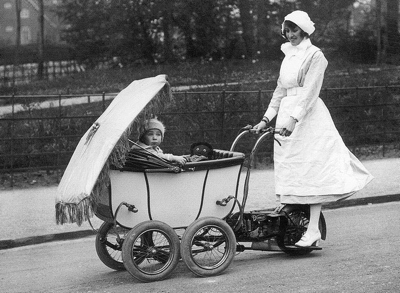Dunkley
|
1896
- 1926 |
Country: |
 |
|
In a world almost devoid of cars, it is easy to understand why motorists of the mid 1890's were not highly critical of the mechanical contraptions being presented as alternatives to the horse and buggy. Mechanical monstrosities like the Pennington Torpedo were accepted without demur, and it had to be a pretty unusual car for the motoring press to notice that it had any shortcomings.
Such a car was built in 1896 by Dunkley of Birmingham. For one thing, its wheels were arranged in diamond formation, the centre pair did the driving, while the outer (smaller) single wheels did the steering. While this layout has been followed by other experimenters throughout motoring history, the Dunkley was unique in that the chassis was so arranged that only one of the
steering wheels touched the ground.
Which one it was, apparently, depended on whether the driver or his rearward-facing passenger was the heavier! To make it more complicated, both driver and passenger had
steering tillers, while the brake lever was entrusted to the passenger, who could not see which way the vehicle was going without twisting themselves around.
Patent Self-charging Gas Motor Cars
Even the motive power was unorthodox, as the Dunkley was designed to run on coal gas. Hardly surprisingly, the company's attempt to market this vehicle lasted no longer than the howls of derision which greeted its appearance. In 1901, Dunkley tried again. This time the company offered the public a range of 'Patent Self-charging Gas Motor Cars', which took their supply of gas from any ordinary gas pipe or street lamp post - although we think it highly unlikely any gas company would have condoned such behaviour.
Dunkley's Number 3
Typical of the breed was the Dunkley's number 3, shown at the 1902 Agricultural Hall Motor Exhibition run by a moustachioed extrovert, Charles Cordingley. The number 3 was a curious tandem two-seater, with the driver in the rear seat. It carried storage tanks holding enough gas for a 100-mile run (so it was claimed - pictures we have seen show the tanks as suspiciously small). These were filled by a patent double-acting gas compressor, which was combined in some way with the car's power unit. This consisted of patent twin engines running together or uncoupled at will by the driver; there were two forward speeds plus reverse.
For some mysterious reason there was a patent reversible
steering handle. Amazingly, this curious vehicle was, in theory at any rate, on the market for several years, though sales must have been minimal. Dunkley, it seems, were convinced that the motor vehicle had a future, even if their opinion of what constituted a winning design was diametrically opposed to the general view.
The Dunkley Alvechurch
In 1911 Dunkley made a fourth attempt to break into the big time. This was their most conventional vehicle, a cyclecar named the Alvechurch after their factory, Alvechurch Works, Bradford Street, Birmingham, England. It was a twin-cylinder-Matchless-engined creation, of which history only records that its driving belts slipped badly and only two examples were built. This venture into conventionality must have frightened Dunkley off, as until 1923 they devoted themselves to their main activity, the manufacture of prams (motor-cycle sidecars, plus a range of motor cycles, were sidelines).
 The Dunkley Pramotor in action.
The Dunkley Pramotor in action.
 The Duke of York inspecting a Dunkley Pramotor at the 1922 London Motor Show.
The Duke of York inspecting a Dunkley Pramotor at the 1922 London Motor Show. |
The Dunkley Pramotor
In 1923, Dunkley made the decision which was to earn them immortality: to produce a motor pram. The heart of this was a unit called the Pramotor, which was basically a scooter with the front' wheel missing.
The one-wheeled power pack could be fastened to the rear of any Dunkley pram: Nanny stood astride the rear wheel, controlling the outfit's hectic progress with twin handlebars bolted to the back of the pram. Power units were originally all 1 hp, horizontal, single-cylinder two-strokes, with bore and stroke dimensions of 2 in x 2 in.
There was only one gear (two-speed gearing appeared a year later), but there was a kick starter and a hand-controlled clutch. Prices ranged from 40 guineas for the Dunkley Model 20 Pramotor outfit, to 135 guineas for the Saloon Pramotor with 26 x 2+ in Palmer Cord motor tyres.
This odd little vehicle, which looked like a five-wheeled Easter Egg, had proper Ackermann steering, mud-guards and running boards, and cost only £24 less than a complete Austin Seven. Or, indeed, as much as a Model T Ford!
Roadholding Capabilities Of The Average Perambulator
An economy Pramotor appeared in 1924, with one gear, and no clutch or kick-starter. For sporting Nannies there was also the option of a 21 hp engine - a 750 cc two-stroke single - which at 75 guineas promised performance far beyond the roadholding capabilities of the average perambulator, as the Pramotors were prohibited by law from using public footpaths or parks. They had to mix it on the open road with more conventional, more controllable vehicles.
Fortunately, leastwise for the infant mortality statistics, sales of Pramotors were low: but when production ceased in 1925, the motoring scene was deprived of one of its spectacular eccentricities. The number 3 was shown at the 1902 Agricultural Hall Motor Exhibition. It was a tandem two-seater with the driver sitting at the rear.



